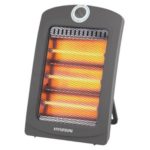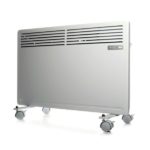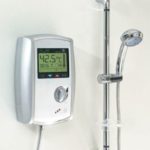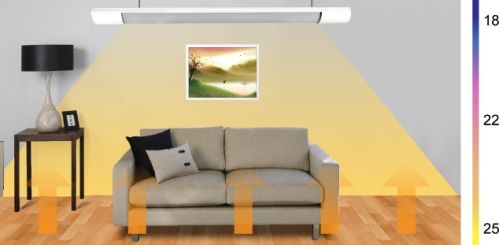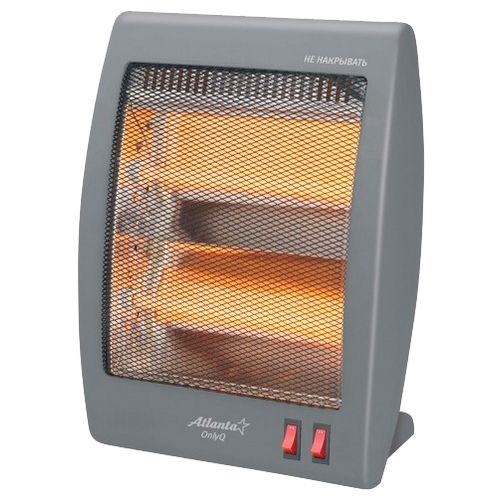Operating principle of an infrared heater
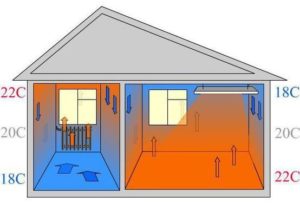 The climate in our country is quite harsh and this leads to high costs of maintaining comfortable living conditions. Therefore, the issue of obtaining relatively cheap thermal energy, which will be used to heat residential and industrial premises, is considered of particular relevance for us. There is probably no heating method that is not used in our country, and one of them is the use of infrared heating. Since the appearance of infrared heating devices on the climate equipment market, they have gradually gained steady popularity. They are also purchased for heating residential premises, as well as industrial workshops, warehouses, and shopping and office centers.
The climate in our country is quite harsh and this leads to high costs of maintaining comfortable living conditions. Therefore, the issue of obtaining relatively cheap thermal energy, which will be used to heat residential and industrial premises, is considered of particular relevance for us. There is probably no heating method that is not used in our country, and one of them is the use of infrared heating. Since the appearance of infrared heating devices on the climate equipment market, they have gradually gained steady popularity. They are also purchased for heating residential premises, as well as industrial workshops, warehouses, and shopping and office centers.
It is quite natural that the design and operating principles of such equipment arouse interest from potential consumers. Let's try to understand this issue.
The content of the article
How does an infrared heater work?
Sometimes devices of this type are called home solar. In fact, everyone walked outside on a frosty and sunny day and probably everyone felt the rays pierce the body and spread over it with pleasant warmth. And immediately it becomes not so cold, although there is snow everywhere.
The sun gives warmth to everyone without exception.Because of its rays, the snow melts, the trees warm up, but only the air does not warm up, and therefore even on a bright sunny day it will be cold outside. This is exactly the operating principle of an infrared heater. The device generates rays invisible to the eye, warming both the person and the objects around him. The surrounding air, in turn, receives thermal energy from heated things.
Device design
There are many other equipment on the market designed for heating rooms, from traditional heat guns to oil radiators and similar equipment. All of the above devices generate heat according to the following scheme:
- Heating the coolant inside the devices. The coolant can be water, heated air, oil and many others.
- The heated coolant transfers thermal energy to the air and only after that the heat reaches the person.
This approach is not effective, but is expensive. Even in a school physics course, it was proven that heated air is lighter than cooled air. As it warms up, it moves upward and accumulates under the ceiling. Due to the action of the infrared heater, temperature differences between the upper and lower levels of the room are reduced. This result is ensured due to the fact that all objects in the room are heated by infrared radiation.
This approach not only creates a favorable microclimate in the room, but also significantly reduces the cost of heat generation, since there is no direct heating of the air in the room. Another. When using infrared heaters, there is no such thing as air overheating.Due to the use of traditional means of heating rooms, an increased air temperature cannot be established; this negatively affects the human body.
REFERENCE. The principles underlying the operation of the IR heater are that it is permissible to maintain the temperature at a level lower than normal. And the room will be quite comfortable even if the room is relatively cool.
Another advantage of heaters of this type is instant response. That is, the generation of infrared radiation begins immediately after switching on. Equipment of this class can be used to heat large rooms without spending either time or additional energy on heating the entire room.
Traditional air heaters are not able to provide optimal heat balance in a room. Infrared models do not heat the air in the room, which means the temperature difference between the lower and upper levels will be kept to a minimum. This allows you to leave the doors between rooms wide open and heat loss will soon be restored.
Many buildings, regardless of their purpose, are equipped with ventilation systems that collect air from the floor to the ceiling. In this case, the optimal solution would be to install IR heaters on the ceiling. When using them, the problem of heat loss from the floor and other surfaces disappears. Heating systems are built on this principle, making it possible to heat large rooms and at the same time they are not very expensive.
The ceiling heater is not only efficient, but also economical. As practice shows, reducing the temperature in a room by one degree can save up to 5% of energy.
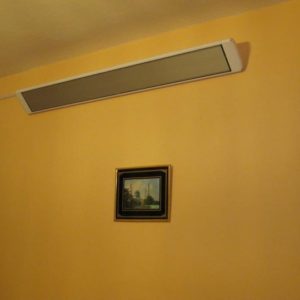 The equipment operates instantly, and there is no need to wait for it to heat up at the required temperature. IR heating devices are equipped with thermostats, controllers and other equipment that make it possible to increase the operating efficiency of heaters of this type. All installed fittings are easy to control and this allows you to provide favorable microclimatic conditions quite quickly. The key operating principle of a heater of this class is that it heats the entire room as a whole and evenly. In this case, there will be no overly heated or cooled parts. That is, the principle is the same as that of the sun's rays, that is, heat will flood the entire area of the room uniformly. All that remains is to calculate the required power and select the necessary equipment.
The equipment operates instantly, and there is no need to wait for it to heat up at the required temperature. IR heating devices are equipped with thermostats, controllers and other equipment that make it possible to increase the operating efficiency of heaters of this type. All installed fittings are easy to control and this allows you to provide favorable microclimatic conditions quite quickly. The key operating principle of a heater of this class is that it heats the entire room as a whole and evenly. In this case, there will be no overly heated or cooled parts. That is, the principle is the same as that of the sun's rays, that is, heat will flood the entire area of the room uniformly. All that remains is to calculate the required power and select the necessary equipment.
Calculating power involves taking into account the following characteristics:
- volume of the room, warehouse, workshop;
- height from floor to ceiling;
- the type of room in which the equipment will be installed;
- the total amount of power consumed.
Infrared technology can be used in any type of premises:
- urban housing;
- private houses;
- offices;
- production workshops;
- retail outlets and many others.
Devices have been developed that are installed in winter gardens and greenhouses. With a ceiling height of 2.4 meters, units of increased power are purchased.
The main advantage of heating systems of this class is ease of installation. They are mounted on the ceiling, for this you can use the fittings of lighting systems. But other installation methods are often used, for example, heaters can be fixed to horizontally installed cables, sometimes a pendulum type suspension is used.
Infrared heat sources have an unusual property. They are able to create a favorable microclimate in the room at a temperature level lower than traditional ones, that is, a traditional heater guarantees 22 degrees Celsius, while an infrared heater provides 20 degrees. The reason for this is that people receive thermal energy directly, bypassing the air preparation stage.
The user gets the opportunity to configure local heating in a separate area. This option is good for heating large rooms, that is, you can obtain optimal temperature conditions at low costs of electrical energy.
Heaters of this class are able to work effectively together with a ventilation system. Such systems show great effect if air supply is arranged through the floor. Thermal energy losses will be compensated through the vertical and horizontal surfaces available in the room. This solution allows for optimal heating of the room with a relatively small investment.
REFERENCE. In some heaters of this class, the heating element is enclosed in a glass flask into which an inert gas is pumped. This slightly reduces the efficiency, but at the same time, gas mixtures can be combined so that the transmission of radiation becomes even faster.
Advantages and disadvantages
This class of thermal equipment has the following advantages:
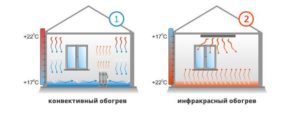 Easy to install and connect.
Easy to install and connect.- Quick creation of a favorable microclimate both in the room as a whole and when using heaters for local heating.
- The user gets the opportunity to create local heating zones.
- No need for periodic or ongoing maintenance.
- Indoor humidity losses are minimized.
Meanwhile, the devices also have certain disadvantages:
- High cost in comparison with similar equipment of other classes.
- There is virtually no mobility; as a rule, they are installed permanently.
- Long warm-up time for large areas.
- Impossibility of use in rooms and premises with ceiling heights of less than 2.5 m.
- Restriction on use in close proximity to furniture, interior items, and household appliances.
- Possibility of deterioration in the health of people constantly exposed to infrared radiation.
- There is a high risk of thermal burns, eye damage, etc.
As a rule, consumers, having become acquainted with heaters of this class and learned their advantages and disadvantages, as a rule, stop paying attention to heaters of another type. But at the same time, the use of devices of this class must be approached with special care. PWhen purchasing such units, you must make sure that they have all the necessary certificates.

